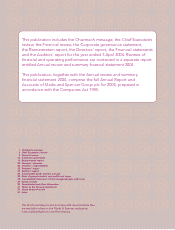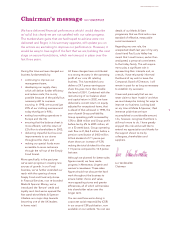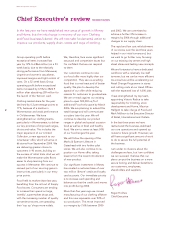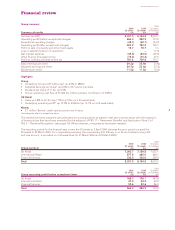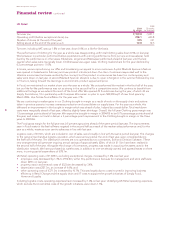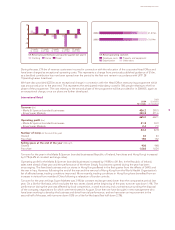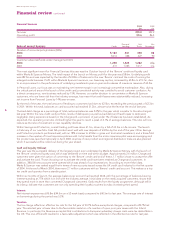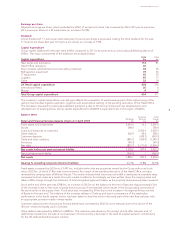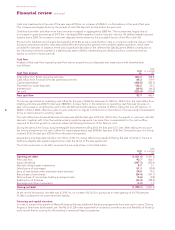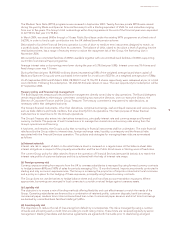Marks and Spencer 2004 Annual Report Download - page 11
Download and view the complete annual report
Please find page 11 of the 2004 Marks and Spencer annual report below. You can navigate through the pages in the report by either clicking on the pages listed below, or by using the keyword search tool below to find specific information within the annual report.
9
www.marksandspencer.com
The Medium Term Note (MTN) programme was renewed in September 2003. Twenty-five new private MTNs were issued
during the year by Marks and Spencer Financial Services plc with a Sterling equivalent of £544.1m and maturities ranging
from one to five years. The Group’s total outstandings within this programme at the end of the financial year were equivalent
to £2,196.5m (last year £1,754.8m).
In March 2004, we raised £400m through a 10-year Public Bond Issue under the existing MTN programme at a fixed rate of
5.625%, in order to fund a cash contribution into the UK defined benefit pension scheme.
Debt raised to fund the Financial Services operation is a mix of short to medium term instruments designed to match, on
a portfolio basis, the income stream from its customers. The balance of debt, raised to introduce a level of gearing into the
retail balance sheet, has a range of maturity terms to reduce the repayment risk of the Group, the first being due in
November 2006.
We currently have committed facilities of £405m available together with uncommitted bank facilities of £430m supporting
our £1.5bn Commercial Paper programme.
Average interest rates on borrowings were lower during the year at 5.3% (last year 5.8%). Interest cover was 18.4 times and
fixed charge cover was 7.3 times.
During the financial year, 18,490,000 ordinary shares (representing 0.8% of the weighted average issued share capital of
Marks and Spencer Group plc) were purchased in the market for a total cost of £52.9m, at a weighted average price of 286p.
On 25 September 2003 and 25 March 2004, 28,398,331 and 19,176,707 B shares respectively, were redeemed at par, at a total
cost of £33.4m. Following this redemption, 121,244,763 B shares remain in issue. The next opportunity for redemption will be
27 September 2004.
Treasury policy and financial risk management
The Board approves treasury policies and senior management directly control day-to-day operations. The Board delegates
certain responsibilities to the treasury committee, comprising two executive directors, one non-executive director, the
Director of Corporate Finance and the Group Treasurer. The treasury committee is empowered to take decisions, as
necessary, within that delegated authority.
The Group’s financial instruments, other than derivatives, comprise borrowings, cash and liquid resources and various items,
such as trade debtors and trade creditors, that arise directly from its operations. The main purpose of these financial
instruments is to raise finance for the Group’s operations.
The Group’s Treasury also enters into derivatives transactions, principally interest rate and currency swaps and forward
currency contracts. The purpose of such transactions is to manage the interest rate and currency risks arising from the
Group’s operations and financing.
It has been, and remains, the Group’s policy that no trading in financial instruments shall be undertaken. The main financial
risks faced by the Group relate to interest rates, foreign exchange rates, liquidity, counterparty and the financial risks
associated with the Financial Services operation. The policies and strategies for managing these risks are summarised
as follows:
(a) Interest rate risk
Interest rate risk in respect of debt on the retail balance sheet is reviewed on a regular basis. At the balance sheet date
interest obligations in respect of the property securitisation and the two Public Bond issues in Sterling were at fixed rates.
The current Group policy for debt raised to finance the operation of Financial Services (see part (e) below), is to match the
interest rate profile of customer balances and this is achieved with the help of interest rate swaps.
(b) Foreign currency risk
Currency exposure arising from exports from the UK to overseas subsidiaries is managed by using forward currency contracts
to hedge between 80% and 100% of sales for periods averaging 10 to 15 months forward. Imports are primarily contracted in
sterling and only economic exposures arise. The Group is increasing the proportion of imports contracted in local currencies
and a policy is in place for the hedging of these exposures, principally using forward currency contracts.
The Group does not use derivatives to hedge balance sheet and profit and loss account translation exposures. Where
appropriate, borrowings are arranged in local currencies to provide a natural hedge against overseas assets.
(c) Liquidity risk
The objective is to ensure a mix of funding methods offering flexibility and cost effectiveness to match the needs of the
Group. Operating subsidiaries are financed by a combination of retained profits, customer deposits, bank borrowings,
commercial paper, medium term notes and securitised loan notes. Commercial paper issuance and short term borrowings
are backed by committed bank facilities totalling £1,655m.
(d) Counterparty risk
The objective is to reduce the risk of loss arising from default by counterparties. The risk is managed by using a number
of banks and allocating each a credit limit according to credit rating criteria. These limits are reviewed regularly by senior
management. Dealing mandates and derivative agreements are agreed with the banks prior to deals being arranged.


